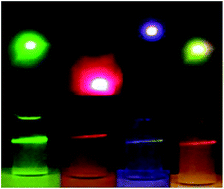Multimodal bioimaging using a rare earth doped Gd2O2S:Yb/Er phosphor with upconversion luminescence and magnetic resonance properties†
Abstract
While infrared upconversion imaging using

Maintenance work is planned for Wednesday 1st May 2024 from 9:00am to 11:00am (BST).
During this time, the performance of our website may be affected - searches may run slowly and some pages may be temporarily unavailable. If this happens, please try refreshing your web browser or try waiting two to three minutes before trying again.
We apologise for any inconvenience this might cause and thank you for your patience.
* Corresponding authors
a
Department of Physics and Astronomy, University of Texas at San Antonio, San Antonio, TX 78249, USA
E-mail:
akgsh@yahoo.com
Fax: +1 2104584919
b Department of Physiology and Barshop Institute, University of Texas Health Science Center at San Antonio, San Antonio, TX 78245, USA
c Research Imaging Institute, Barshop Institute and Department of Cellular & Structural Biology, University of Texas Health Science Center, 7703 Floyd Curl Drive, San Antonio, TX 78229, USA
d UM-DAE Centre for Excellence in Basic Sciences, Health Centre Bldg, University of Mumbai, Kalina Campus, Mumbai 400098, India
e Department of Materials Science and Engineering, Northwestern University, 2220 Campus Drive, Evanston, IL 60208-3108, USA
While infrared upconversion imaging using

 Please wait while we load your content...
Something went wrong. Try again?
Please wait while we load your content...
Something went wrong. Try again?
G. Ajithkumar, B. Yoo, D. E. Goral, P. J. Hornsby, A. Lin, U. Ladiwala, V. P. Dravid and D. K. Sardar, J. Mater. Chem. B, 2013, 1, 1561 DOI: 10.1039/C3TB00551H
To request permission to reproduce material from this article, please go to the Copyright Clearance Center request page.
If you are an author contributing to an RSC publication, you do not need to request permission provided correct acknowledgement is given.
If you are the author of this article, you do not need to request permission to reproduce figures and diagrams provided correct acknowledgement is given. If you want to reproduce the whole article in a third-party publication (excluding your thesis/dissertation for which permission is not required) please go to the Copyright Clearance Center request page.
Read more about how to correctly acknowledge RSC content.
 Fetching data from CrossRef.
Fetching data from CrossRef.
This may take some time to load.
Loading related content
